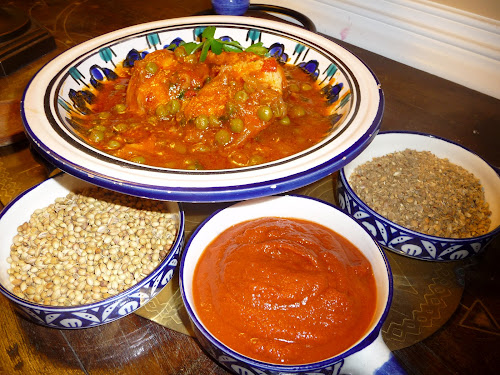Chicken Ragout
Ragout Aux Poulet Et Petits Pois
1/3 cup olive oil
2 medium onions, slivered
2 cloves garlic, minced
1 whole chicken, skinned and cut into pieces
(chicken on the bone makes sauce more flavorful)
1 tsp. pepper
1 tab. salt
1 1/2 tab. tabil (see bottom of blog for recipe)
(or 1 tab. ground coriander, 1 tsp. ground caraway,
and 1 tsp. ground cumin)
2 green peppers, cored, seeded and cut into 1/2 inch slivers
(mild or hot depending on individual preference)
1/2 cup tomato paste
1 tsp. sugar
1 tab. harissa (more if you like it hot)
1 1/2 cups water
1 1/2 cups chicken broth or stock
dash of cayenne pepper
1 1/2 cups fresh or frozen peas
1 cup finely minced flat-leaf parsley
-Saute chicken pieces in large saucepan in oil, with onion, salt and pepper until chicken is browned on all sides and onion is soft. Add garlic, tabil (or coriander and cumin), harissa, water, chicken broth, cayenne pepper, and sugar. Cook ragout uncovered over medium-low heat for 30 - 45 minutes until chicken is tender. Stir occasionally. Add peas and green pepper and simmer an additional 10 minutes. Toss in parsley last 5 minutes of cooking time. Serve in large open soup bowls with crusty French bread. Serves 6 - 8.
Not to be outdone by the far reaching tentacles of British
Imperialism, the French dabbled in the fertile soils of North Africa a century
ago and upon withdrawing it’s cultivating hand, left behind patisseries,
baguettes and ragouts which Tunisians decided were impositions they
would happily embrace. In order to
de-colonize and adapt those frou-frou flavors, rustify the subtle tomato with a robust and piquant character, more in culinary
stride with the earthy Berber tradition, tabil and harissa jumped into the mix
and “Voila” or (in Arabic) – it became a mélange of flavors, not unlike the local dialect itself, where the reply to "Bonjour" became "Bonjouraine" - roughly meaning "hello back at you" - an Arabic construction.
Ragout, from the French "to revive the taste", does just that. Recipes are many and varied, generally implying meat cooked in a thick, well-seasoned sauce. Ragout Aux Poulet et Petits Pois is a simple, hearty dish, the piquant local spices tickling the tomato sauce to where you want to sop every last swipe from the bottom of the bowl with your French baquette. Peas sweeten the sauce of flavors so rich you almost want to swim along with them in the dish!
Ragout Aux Poulet Et Petits Pois
1/3 cup olive oil
2 medium onions, slivered
2 cloves garlic, minced
1 whole chicken, skinned and cut into pieces
(chicken on the bone makes sauce more flavorful)
1 tsp. pepper
1 tab. salt
1 1/2 tab. tabil (see bottom of blog for recipe)
(or 1 tab. ground coriander, 1 tsp. ground caraway,
and 1 tsp. ground cumin)
2 green peppers, cored, seeded and cut into 1/2 inch slivers
(mild or hot depending on individual preference)
1/2 cup tomato paste
1 tsp. sugar
1 tab. harissa (more if you like it hot)
1 1/2 cups water
1 1/2 cups chicken broth or stock
dash of cayenne pepper
1 1/2 cups fresh or frozen peas
1 cup finely minced flat-leaf parsley
-Saute chicken pieces in large saucepan in oil, with onion, salt and pepper until chicken is browned on all sides and onion is soft. Add garlic, tabil (or coriander and cumin), harissa, water, chicken broth, cayenne pepper, and sugar. Cook ragout uncovered over medium-low heat for 30 - 45 minutes until chicken is tender. Stir occasionally. Add peas and green pepper and simmer an additional 10 minutes. Toss in parsley last 5 minutes of cooking time. Serve in large open soup bowls with crusty French bread. Serves 6 - 8.





